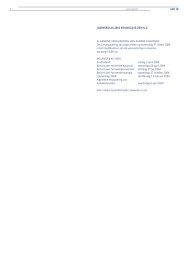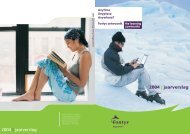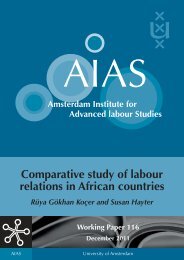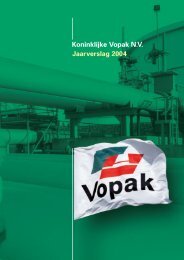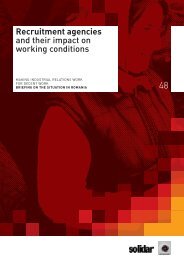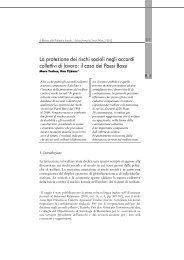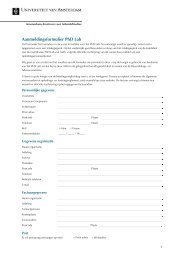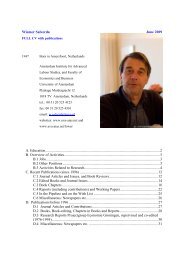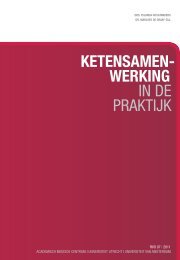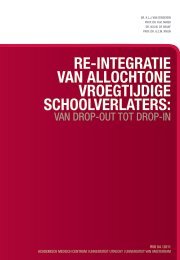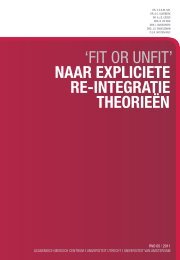Can creative web survey questionnaire design improve the ... - AIAS
Can creative web survey questionnaire design improve the ... - AIAS
Can creative web survey questionnaire design improve the ... - AIAS
Create successful ePaper yourself
Turn your PDF publications into a flip-book with our unique Google optimized e-Paper software.
<strong>Can</strong> <strong>creative</strong> <strong>web</strong> <strong>survey</strong> <strong>questionnaire</strong> <strong>design</strong> <strong>improve</strong> <strong>the</strong> response quality?• • • • • • • • • • • • • • • • • • • • • • • • • • • • • • • • • • • • • • • • • • • • • • • • • • • • • • • • • • • • • • • • • • • • •4. Analysis and resultsAmong all <strong>the</strong> criteria that are studied as indexes of quality, <strong>the</strong> response rate is <strong>the</strong> most frequent. As aprinciple, a <strong>survey</strong> must provide a clear definition of <strong>the</strong> term response rate. For this study as response rate weconsider <strong>the</strong> Standard Definition proposed by AAPOR (2011, p.44), RR2. According to this definition, <strong>the</strong>response rate is defined as <strong>the</strong> number of complete plus <strong>the</strong> partial <strong>questionnaire</strong>s answered, divided by <strong>the</strong>invitees.Two weeks after launching <strong>the</strong> <strong>survey</strong>, we had received 442 answers from <strong>the</strong> group of students withpopup text message and 449 from <strong>the</strong> group of students without <strong>the</strong> text message, representing a globalresponse rate of 29.4%. As mentioned above a single follow-up is sent after <strong>the</strong> end of <strong>the</strong> second week toboost <strong>the</strong> response (Dillman, 2000). By <strong>the</strong> end of <strong>the</strong> <strong>survey</strong> we receive in total 1189 answers representingtotal response rate of 39.2%. The response rate for <strong>the</strong> group with <strong>the</strong> popup text message is 39.7% or 601respondents out of 1515 and 38.8% or 588 out of 1515 for <strong>the</strong> respondents without <strong>the</strong> text message. Table 1clearly shows that <strong>the</strong>re is no statistical significant difference between <strong>the</strong> response rate of <strong>the</strong> two groups (pvalue=0.63122)and <strong>the</strong>refore Hypo<strong>the</strong>sis 1: The response rate is significantly higher for <strong>the</strong> “popup” studentgroup than for <strong>the</strong> “without popup” group, cannot be supported.Table 1Response Rates and DropoutsWithout popuptext messagen (%)With popuptext messagen (%)p-valueTotal units responded 588 (38.8) 601 (39.7) 0.63122Total Population 1515 (100) 1515 (100)Completed 363 (61.7) 418 (69.6) 0.00452***Dropouts 225 (38.3) 183 (30.4) 0.00452***Total units 588 (100) 601 (100)Total eligible 415 (70.6) 460 (76.5) 0.0198**Lurkers (answered at most <strong>the</strong> firstpage/demographics)173 (29.4) 141 (23.5) 0.0198**Total units 588 (100) 601 (100)Note : * p-value
Julijana Angelovskaa and Petroula M. Mavrikioub• • • • • • • • • • • • • • • • • • • • • • • • • • • • • • • • • • • • • • • • • • • • • • • • • • • • • • • • • • • • • • • • • • • • •Yet, <strong>the</strong> opportunity that <strong>the</strong> <strong>web</strong> <strong>survey</strong> software offers by tracking <strong>the</strong> log files on <strong>the</strong> server andmeasuring <strong>the</strong> dropout rates, provide additional results. Respondents that for various reasons, fail to evercomplete <strong>the</strong> <strong>questionnaire</strong> are referred as abandonments, breakoffs, drop-outs, or partials (AAPOR, 2011,p.34). Dropouts are calculated as <strong>the</strong> difference between <strong>the</strong> number of participants that respond and <strong>the</strong>participants who fully complete <strong>the</strong> <strong>questionnaire</strong>. According to report files registered on <strong>the</strong> server, dropoutrate of 30.4% or 183 dropouts’ respondents do not finished <strong>the</strong> <strong>survey</strong> in <strong>the</strong> group with popup text message.Respectively for <strong>the</strong> o<strong>the</strong>r group <strong>the</strong> dropout rate is 38.3% or 225 dropouts. Statistical analysis showssignificant difference in <strong>the</strong>se dropout rates (p-value=0.00452) that strongly support <strong>the</strong> second researchhypo<strong>the</strong>sis; Hypo<strong>the</strong>sis 2: The dropout rate will be significantly lower for <strong>the</strong> “popup” student group than for<strong>the</strong> “without popup” group. In addition, statistically significant difference exist between <strong>the</strong> two group ofstudents whose <strong>questionnaire</strong>s are eligible for analysis (p-value=0.0198). Figure 1 shows <strong>the</strong> time lines for <strong>the</strong>number of dropouts of <strong>the</strong> two groups. It is clear that at <strong>the</strong> majority of <strong>the</strong> time <strong>the</strong> number of dropouts ishigher for <strong>the</strong> group without <strong>the</strong> popup text message. The graph also indicates <strong>the</strong> boost in <strong>the</strong> responses when<strong>the</strong> first reminder is sent.Figure 1: Time series for <strong>the</strong> number of dropouts for <strong>the</strong> two groups3530252015With output- Number ofdropoutsWithout output- Number ofdropouts10501 3 5 7 9 11 13 15 17 19 21 23 25 27 29 31Page • 9<strong>AIAS</strong> 2013 - 131 www.aias-uva.net
<strong>Can</strong> <strong>creative</strong> <strong>web</strong> <strong>survey</strong> <strong>questionnaire</strong> <strong>design</strong> <strong>improve</strong> <strong>the</strong> response quality?• • • • • • • • • • • • • • • • • • • • • • • • • • • • • • • • • • • • • • • • • • • • • • • • • • • • • • • • • • • • • • • • • • • • •Partially empty <strong>questionnaire</strong>s we consider those whose respondents dropped out <strong>the</strong> <strong>web</strong> <strong>survey</strong> withoutresponding to a single item or answered at most <strong>the</strong> first page/demographics, i.e., <strong>the</strong> lurkers. The number oflurkers in <strong>the</strong> first group is 173 out of 588 (29.4%) while in <strong>the</strong> second 141 out of 601 (23.5%). Table 1evidently shows that <strong>the</strong>re is statistically significant difference between <strong>the</strong> lurkers of <strong>the</strong> two groups. As amatter of fact, <strong>the</strong> lurkers in <strong>the</strong> “popup” group are significantly lower than in <strong>the</strong> o<strong>the</strong>r group (pvalue=0.0198)adding value to <strong>the</strong> second hypo<strong>the</strong>sis. The difference between <strong>the</strong> dropout respondents and <strong>the</strong>lurkers are also considered eligible for statistical analysis. Actually, in both groups dropouts occur aftercompleting <strong>the</strong> first page, in o<strong>the</strong>r words after answering <strong>the</strong> demographics on first page. This shows that <strong>the</strong>usage of <strong>the</strong> feature of forced answering, i.e. <strong>the</strong> obligatory completion of each question does not seem toaffect <strong>the</strong> initial decision of <strong>the</strong> respondent to finish or not <strong>the</strong> <strong>questionnaire</strong>.As mentioned before, measurement of quality of responses in this <strong>web</strong> <strong>survey</strong> is done through dropoutrate. We consider dropout rate to be more suitable than item non response, because of <strong>the</strong> implementation offorced answering. Inevitable, quality of responses for <strong>the</strong> group with <strong>the</strong> popup text message is higher than <strong>the</strong>group without and this is thanks to <strong>the</strong> <strong>creative</strong> text message at <strong>the</strong> end of one of <strong>the</strong> <strong>questionnaire</strong>s.<strong>AIAS</strong> 2013 - 130 www.aias-uva.net Page • 10
Julijana Angelovskaa and Petroula M. Mavrikioub• • • • • • • • • • • • • • • • • • • • • • • • • • • • • • • • • • • • • • • • • • • • • • • • • • • • • • • • • • • • • • • • • • • • •5. ConclusionThe purpose of this study is through an experiment to test a new method for increasing response rate anddecrease dropouts rate in online <strong>survey</strong>s. A new method is implemented in this research: conditional popupwith text message describing <strong>the</strong> level of procrastination of <strong>the</strong> student depending on <strong>the</strong> scores of answers anddeclared grades. Web <strong>survey</strong> <strong>questionnaire</strong> is fielded on population of university students to test whe<strong>the</strong>rdisplaying popup text will motivate participation and <strong>the</strong> engagement of more students.The results of <strong>the</strong> experiment are <strong>the</strong> expected ones and coincide with international findings. The increasedparticipation formulated in <strong>the</strong> first hypo<strong>the</strong>sis is not supported, or response rate was not significantly higher in<strong>the</strong> group with <strong>the</strong> popup <strong>questionnaire</strong>. A concern is <strong>the</strong> high probability that invitees may only have seen <strong>the</strong>email, have read <strong>the</strong> content, clicked <strong>the</strong> link and it is a question if <strong>the</strong>y have read <strong>the</strong> introduction of <strong>the</strong><strong>questionnaire</strong> at all. Fur<strong>the</strong>r investigation is needed on how to be <strong>creative</strong> in order to attract and engageinvitees. The second hypo<strong>the</strong>sis which claims that <strong>the</strong> <strong>questionnaire</strong> with <strong>the</strong> popup will engage more studentsit is supported and <strong>the</strong> dropouts are statistically significant lower in <strong>the</strong> experiment with this group. Sakshaugand Crawford (2010), stress that text messages can be even more successful if additional material is presentedat <strong>the</strong> end of <strong>the</strong> <strong>survey</strong> as description or in <strong>the</strong> form of a randomly chosen picture. In this study, <strong>the</strong> differencebetween <strong>the</strong> two groups is <strong>the</strong> implementation of <strong>the</strong> popup text message in <strong>the</strong> <strong>web</strong> <strong>design</strong> of <strong>the</strong> second<strong>questionnaire</strong>. It can be concluded that students may have been curious to read <strong>the</strong> popup text message and<strong>the</strong>refore <strong>creative</strong> <strong>design</strong> of <strong>the</strong> <strong>questionnaire</strong> <strong>improve</strong>d <strong>the</strong> response quality.The experiment could be even more successful if during <strong>the</strong> <strong>survey</strong> some text messages appear during <strong>the</strong><strong>survey</strong> to remind students that <strong>the</strong>re is a popup text message at <strong>the</strong> end. These messages need to be motivating,and encouraging with ultimate purpose <strong>the</strong> engagement of student until <strong>the</strong> end of <strong>the</strong> <strong>survey</strong>. Some examplesare: “See what kind of student you are”, “Are you a perfect student or are you a perfect procrastinator?”One of <strong>the</strong> biggest concerns when someone is conducting a <strong>survey</strong> is to <strong>improve</strong> <strong>the</strong> engagement ofrespondent and <strong>the</strong> quality of responses. The implementation of <strong>creative</strong>ness in <strong>the</strong> <strong>questionnaire</strong> thatnowadays is easily achieved with <strong>web</strong> <strong>survey</strong> tools can be an alternative to ease <strong>the</strong>se concerns. It is just amatter of ideas of <strong>the</strong> researchers and <strong>the</strong>ir innovation to attract <strong>the</strong> invitees to respond and to retain. Thisstudy contributes to <strong>the</strong> body of literature on improving <strong>the</strong> <strong>design</strong> and effectiveness of <strong>the</strong> <strong>web</strong> based <strong>survey</strong>process.Page • 11<strong>AIAS</strong> 2013 - 131 www.aias-uva.net
<strong>Can</strong> <strong>creative</strong> <strong>web</strong> <strong>survey</strong> <strong>questionnaire</strong> <strong>design</strong> <strong>improve</strong> <strong>the</strong> response quality?• • • • • • • • • • • • • • • • • • • • • • • • • • • • • • • • • • • • • • • • • • • • • • • • • • • • • • • • • • • • • • • • • • • • •ReferencesAAPOR, American Association for Public Opinion Research. (2011) Standard Definitions: Final Dispositions ofCase Codes and Outcome Rates for Surveys, Retrieve fromhttp://www.aapor.org/AM/Template.cfm?Section=Standard_Definitions2&Template=/CM/ContentDisplay.cfm&ContentID=3156Baatard, G. (2012). A Technical Guide to Effective and Accessible Web Surveys. The Electronic Journal of BusinessResearch Methods 10(2), 101-109.Best, S. J., & Krueger, B. S. (2004). Internet data collection, quantitative applications in <strong>the</strong> social sciences. ThousandOaks: Sage Publications.Brick, J. M., & Williams, D. (2013). Explaining rising nonresponse rates in cross-sectional <strong>survey</strong>s. The Annals of<strong>the</strong> American Academy of Political and Social Science, 645(1), 36-59.Burka, J. B., & Yuen, L. M. (2008). Procrastination: Why you do it, what to do about it now. Cambridge: De CapoPress.Church, A. H. (1993). Estimating <strong>the</strong> effect of incentives on mail <strong>survey</strong> response rates: A meta-analysis. PublicOpinion Quarterly, 57, 62-79.Conrad, F. G., Couper, M. P., Tourangeau, R., & Galesic, M. (2005). Interactive Feedback <strong>Can</strong> Improve <strong>the</strong>Quality of Responses in Web Surveys. The American Association for Public Opinion Research (AAPOR) 60th AnnualConference.Converse, P. D., Wolfe, E. W., Huang, X., & Oswald, F. L. (2008). Response Rates for Mixed-Mode SurveysUsing Mail and EMail/Web. American Journal of Evaluation, 29(1), 99-107.Cook, C., Heath, F., & Thompson, R. L. (2000). A meta-analysis of response rates in <strong>web</strong>- or Internet-based<strong>survey</strong>s. Educational and Psychological Measurement, 60, 821-836.Couper, M. (2000). Web Surveys: A Review of Issues and Approaches. Public Opinion Quarterly, 64(4), 464-494.Couper, M., Traugott M., Lamias M. (2001). Web Survey Design and Implementation. Public Opinion Quarterly,65, 230-253.Couper, M. (2008). Designing Effective Web Surveys. New York: Cambridge Iniversity Press.Couper, M. P., & Miller, P. V. (2008). Web Survey Methods: Introduction. Public Opinion Quarterly, 72(5), 831-835.<strong>AIAS</strong> 2013 - 130 www.aias-uva.net Page • 12
Julijana Angelovskaa and Petroula M. Mavrikioub• • • • • • • • • • • • • • • • • • • • • • • • • • • • • • • • • • • • • • • • • • • • • • • • • • • • • • • • • • • • • • • • • • • • •Crawford, S. D., Couper, M. P., and Lamias, M. (2001), Web Surveys: Perceptions of Burden. Social ScienceComputer Review, 19(2): 146-162.Davey, E. (1996). Noninterview Rates for Selected Major Demographic Household Surveys. internal Census Bureau.Deutskens, E., de Ruyter, K., & Wetzels, M. (2006). An Assessment of Equivalence Between Online and MailSurveys in Service Research. Journal of Service Research, 8(4), 346-355.Dillman, D. A. (2000). Mail and internet <strong>survey</strong>s, <strong>the</strong> tailored <strong>design</strong> method (2nd ed.). New York: John Wiley & Sons.Dillman, D. A., Smyth, J. D., & Christian, L. M. (2009). Internet, Mail, and Mixed-Mode Surveys: The Tailored DesignMethod. Hoboken,New Jersey: John Wiley & Sons, Inc.Downes-Le Guin, T., Baker, R., Mechling, J., & Ruylea, E. (2012). Myths and realities of respondentengagement in online <strong>survey</strong>s. International Journal of Market Research, 54(5), 1-21.Edwards, P., Roberts, I., Clarke, M., DiGuiseppi, C., Pratap, S., Wentz, R., & Kwan, I. (2002). Increasingresponse rates to postal <strong>questionnaire</strong>s: Systematic review. British Medical Journal, 324, 1183-1185.Ellis, A., & Knaus, W. J. (1977). Overcoming procrastination. NY: Signet Books.Ferrari, J. R. (1991). Compulsive procrastination: Some self-reported characteristics. Psychol. Rep.(68), 455-458.Ferrari, J. R., Johnson, J., & McCown, W. G. (1995). Procrastination and task avoidance: Theory, research, and treatment.New York: Plenum Press.Fricker, R. D., & Schonlau, M. (2002). Advantages and Disadvantages of Internet Research Surveys: Evidencefrom <strong>the</strong> Literature. Field Methods, 14(4), 347-367.Ganassali, S. (2008). The Influence of <strong>the</strong> Design of Web Survey Questionnaires on <strong>the</strong> Quality of Responses.Survey Research Methods 2(1), 21-32.Groves, R. (1989). Survey Errors and Survey Costs. New York: Wiley and Sons.Haycock, L. A., McCarthy, P., & Skay, C. L. (1998). Procrastination in college students: <strong>the</strong> role of self-efficacyand anxiety. Journal of Counseling and Development, 76(3), 317-325.Heerwegh, D., & Loosveldt, G. (2006). An experimental study on <strong>the</strong> effects of personalization, <strong>survey</strong> lengthstatements, progress indicators, and <strong>survey</strong> sponsor logos in Web <strong>survey</strong>s. Journal of Official Statistics, 22, 191-210.Hewitt, P. L., & Flett, G. L. (1991). Dimensions of perfectionism in unipolar depression. Journal of AbnormalPsychology, 100, 98-101.Page • 13<strong>AIAS</strong> 2013 - 131 www.aias-uva.net
<strong>Can</strong> <strong>creative</strong> <strong>web</strong> <strong>survey</strong> <strong>questionnaire</strong> <strong>design</strong> <strong>improve</strong> <strong>the</strong> response quality?• • • • • • • • • • • • • • • • • • • • • • • • • • • • • • • • • • • • • • • • • • • • • • • • • • • • • • • • • • • • • • • • • • • • •Kaplowitz, M. D., Hadlock, T. D., & Levine, R. (2004). A Comparison of Web and Mail Survey ResponseRates. Public Opinion Quarterly, 68 (1), 94-101.Klibert, J., Langhinrichsen-Rohling, J., & Saito, M. (2005). Adaptive and maladaptive aspects of self-orientedversus socially prescribed perfectionism. Journal of College Student Development, 46(2), 141-156.Krosnick, J. (1991). Response strategies for coping with <strong>the</strong> cognitive demands of attitude measures in <strong>survey</strong>s.Applied Cognitive Psychology. 5(2) 13-36.Lozar Manfreda, K., Bosnjak, M., Berzelak, J., Haas, I., & Vehovar, V. (2008). Web Surveys versus O<strong>the</strong>rSurvey Modes; A Meta-Analysis Comparing Response Rates. International Journal of Market Research, 50(1), 79-104.Lusk, C., Delclos, G. L., Burau, K., Drawhorn, D. D., & Aday, L. A. (2007). Mail versus Internet <strong>survey</strong>s:Determinants of method of response preferences among health professionals. Evaluation & <strong>the</strong> HealthProfessions, 30(2), 186-201.Lyons, A. C., Cude, B., Lawrence, F. C., & Gutter, M. (2005). Conducting Research Online: Challenges FacingResearchers in Family and Consumer Sciences. Family and Consumer Sciences Research Journal, 33(4), 341-356.Malhotra, N. (2008). Completion Time and Response Order Effects in Web Surveys. Public Opinion Quarterly,72(5), 914-934.Marcus, B., Bosnjak, M., Lindner, S., & Schütz, A. (2007). Compensating for Low Topic Interest and LongSurveys A Field Experiment on Nonresponse in Web <strong>survey</strong>. Social Science Computer Review, 25(3), 372-383.Matzat, U., Snijders, C., & van der Horst, W. (2009). The effects of different types of progress indicators ondrop-out rates in Web <strong>survey</strong>s. Social Psychology, 40, 43–52.Milgram, N., Mey-Tal, G., & Levison, Y. (1998). Procrastination, generalized or specific, in college students and<strong>the</strong>ir parents. Pers. Indiv. Differ. 25(2), 297-316.Milgram, N. A. (1991). Procrastination in R. Dulbecco (Ed.). Encyclopedia of Human Biology(6), 149-155.Parker, L. (1992). Collecting Data <strong>the</strong> E-Mail Way. Training and Development, July 52-54.Sakshaug, J. W., & Crawford S. D. (2010). The Impact of Textual Messages of Encouragement on Web.International Journal of Internet Science 4(1), 50-60.Schmidt, W. (1997). World-Wide Web <strong>survey</strong> research: Benefits, potential problems, and solutions. BehaviorResearch Methods, 29(2), 274-279.Sheehan, K. (2001). E-mail <strong>survey</strong> response rates: A review. Journal of Computer-Mediated Communication 6(2).<strong>AIAS</strong> 2013 - 130 www.aias-uva.net Page • 14
Julijana Angelovskaa and Petroula M. Mavrikioub• • • • • • • • • • • • • • • • • • • • • • • • • • • • • • • • • • • • • • • • • • • • • • • • • • • • • • • • • • • • • • • • • • • • •Shih, T. H., & Fan, X. (2008). Comparing Response Rates from Web and Mail Surveys: A Meta-Analysis. FieldMethods, 20(3), 249-271.Sleep, D., & Puleston, J. (2008). The <strong>survey</strong> killer. Quirk’s Marketing Research Review.Steel, P. (2007). The nature of procrastination: A meta-analytic and <strong>the</strong>oretical review of quintessential selfregulatoryfailure. Psychological Bulletin(133), 65-94.Stewart, D. W., & Pavlou, P. A. (2002). From consumer response to active consumer: measuring <strong>the</strong>effectiveness of interactive media. Journal of <strong>the</strong> Academy of Marketing Science, 30(4) 376-396.Tuckman, B. W. (1991). The development and concurrent validity of <strong>the</strong> Procrastination Scale. Educational andPsychological Measurement, 51(2), 473-480.van Selm, M., & Jankowski, N. W. (2006). Conducting Online Surveys. Quality & Quantity, 40( 3), 435-456.Vicente, P., & Reis, E. (2010). Using Questionnaire Design to Fight Nonresponse Bias in Web Surveys. SocialScience Computer Review, 28(2), 251-267.Yammarino, F. J., Skinner, S. J., & Childers, T. L. (1991). Understanding mail <strong>survey</strong> response behavior. PublicOpinion Quarterly, 55, 613-639.Zhang, Y. (2000). Using <strong>the</strong> Internet for Survey Research: A Case Study. Journal of Education for Library andInformation Science, 5, 57-68.Zichermann, G. & Cunningham, C. (2011). Gamification by Design: Implementing Game Mechanics in Web andMobileApps. Sebastopol, 2011: O’Reilly.Page • 15<strong>AIAS</strong> 2013 - 131 www.aias-uva.net
<strong>Can</strong> <strong>creative</strong> <strong>web</strong> <strong>survey</strong> <strong>questionnaire</strong> <strong>design</strong> <strong>improve</strong> <strong>the</strong> response quality?• • • • • • • • • • • • • • • • • • • • • • • • • • • • • • • • • • • • • • • • • • • • • • • • • • • • • • • • • • • • • • • • • • • • •<strong>AIAS</strong> Working PaperRecent publications of <strong>the</strong> Amsterdam Institute for Advanced Labour Studies. They can be downloaded fromour <strong>web</strong>site www.uva-aias.net under <strong>the</strong> subject Publications.130 Forthcoming:WebdatametricsPablo de Pedraza and Ulf D. Reips129 Children, Elder Care and <strong>the</strong> Probalilities Spanish Woman have of Holding Decent WorksJuly 2013 - Alberto Villacampa González and Pablo de Pedraza García128 Collectieve Zeggenschap in het Nederlandse Pensioenstelsel: De BeroepspensioenverenigingApril 2013 - Natascha van der Zwan127 More or less strangers. Social distance as reflected in news media reporting on <strong>the</strong> young, <strong>the</strong> oldand <strong>the</strong> allochthonDecember 2012 - Dorota Lepianka126 Development of <strong>the</strong> public-private wage differential in <strong>the</strong> Ne<strong>the</strong>rlands 1979 – 2009December 2012 - Ernest Berkhout and Wiemer Salverda125 Solidarity in a multicultural neighbourhood Results of a field experimentDecember 2012 - Paul de Beer and Maarten Berg124 Conditions and motives for voluntary sharing: Results of a solidarity game experimentDecember 2012 - Paul de Beer and Maarten Berg123 “Gone Fishing” Modeling Diversity in Work EthicsNovember 2012 - Annette Freyberg-Inan and Rüya Gökhan Koçer122 Skill-based inequality in job qualityAugust 2012 - Haya Stier121 Skill-based inequality in job quality: A multilevel frameworkAugust 2012 - Haya Stier and Meir Yaish120 The impact of attitudes and work preferences on Dutch mo<strong>the</strong>rs’ employment patternsApril 2012 - Justine Ruitenberg and Paul de Beer119 “He would never just hit <strong>the</strong> sofa” A narrative of non-complaining among Dutch Mo<strong>the</strong>rs.A qualitative study of <strong>the</strong> influences of attitudes on work preferences and employment patterns ofDutch mo<strong>the</strong>rsApril 2012 - Justine Ruitenberg118 Collective redress and workers’ rights in <strong>the</strong> EUMarch 2012 - Jan Cremers and Martin Bulla117 Forthcoming: An individual level perspective on <strong>the</strong> concept of flexicurityAntonio Firinu116 Comparative study of labour relations in African countriesDecember 2011 - Rüya Gökhan Koçer and Susan Hayter115 More flexibility for more innovation?<strong>AIAS</strong> 2013 - 130 www.aias-uva.net Page • 16
Julijana Angelovskaa and Petroula M. Mavrikioub• • • • • • • • • • • • • • • • • • • • • • • • • • • • • • • • • • • • • • • • • • • • • • • • • • • • • • • • • • • • • • • • • • • • •December 2011 - Eva Wachsen and Knut Blind114 De loonkloof tussen mannen en vrouwen. Een review van het onderzoek in NederlandDecember 2011 - Kea G. Tijdens en Maarten van Klaveren113 European social dialogue as multi-level governance. Towards more autonomy and new dependenciesSeptember 2011 - Paul Marginson and Maarten Keune112 Flexicurity: a new impulse for social dialogue in Europe?September 2011 - Maarten Keune11-111 Health workforce remuneration. Comparing wage levels, ranking and dispersion of 16 occupationalgroups in 20 countriesAugust 2011 - Kea Tijdens and Daniel H. de Vries11-110 Over- and underqualification of migrant workers. Evidence from WageIndicator <strong>survey</strong> dataJuly 2011 - Kea Tijdens and Maarten van Klaveren11-109 Employees’ experiences of <strong>the</strong> impact of <strong>the</strong> economic crisis in 2009 and 2010July 2011 - Kea Tijdens, Maarten van Klaveren, Reinhard Bispinck, Heiner Dribbusch and Fikret Öz11-108 A deeper insight into <strong>the</strong> ethnic make-up of school cohorts: Diversity and school achievementJanuary 2011 - Virginia Maestri11-107 Codebook and explanatory note on <strong>the</strong> EurOccupations dataset about <strong>the</strong> job content of150 occupationsJanuary 2011 - Kea Tijdens, Es<strong>the</strong>r de Ruijter and Judith de Ruijter10-106 The Future of Employment Relations: Goodbye ‘Flexicurity’ – Welcome Back Transitional LabourMarkets?2010 - Gün<strong>the</strong>r Schmid11-105 Forthcoming:This time is different ?! The depth of <strong>the</strong> Financial Crisis and its effects in <strong>the</strong> Ne<strong>the</strong>rlands.Wiemer Salverda11-104 Forthcoming:Integrate to integrate. Explaining institutional change in <strong>the</strong> public employment service - <strong>the</strong>one shop officeMarieke Beentjes, Jelle Visser and Marloes de Graaf-Zijl11-103 Separate, joint or integrated? Active labour market policy for unemployed on social assistance andunemployment benefits2011 - Lucy Kok, Caroline Berden and Marloes de Graaf-Zijl10-102 Codebook and explanatory note on <strong>the</strong> WageIndicator dataset a worldwide, continuous, multilingual<strong>web</strong>-<strong>survey</strong> on work and wages with paper supplements2010 - Kea Tijdens, Sanne van Zijl, Melanie Hughie-Williams, Maarten van Klaveren,Stephanie Steinmetz10-101 Uitkeringsgebruik van Migranten2010 - Aslan Zorlu, Joop Hartog and Marieke Beentjes10-100 Low wages in <strong>the</strong> retail industry in <strong>the</strong> Ne<strong>the</strong>rlands. RSF project Future of work in Europe /Low-wage Employment: Opportunity in <strong>the</strong> Workplace in Europe and <strong>the</strong> USA2010 - Maarten van KlaverenPage • 17<strong>AIAS</strong> 2013 - 131 www.aias-uva.net
<strong>Can</strong> <strong>creative</strong> <strong>web</strong> <strong>survey</strong> <strong>questionnaire</strong> <strong>design</strong> <strong>improve</strong> <strong>the</strong> response quality?• • • • • • • • • • • • • • • • • • • • • • • • • • • • • • • • • • • • • • • • • • • • • • • • • • • • • • • • • • • • • • • • • • • • •10-99 Pension fund governance. The intergenerational conflict over risk and contributions2010 - David Hollanders10-98 The greying of <strong>the</strong> median voter. Aging and <strong>the</strong> politics of <strong>the</strong> welfare state in OECDcountries2010 - David Hollanders and Ferry Koster10-97 An overview of women’s work and employment in ZimbabweDecisions for Life Country Report2010 - Maarten van Klaveren, Kea Tijdens, Melanie Hughie-Williams and Nuria Ramos10-96 An overview of women’s work and employment in BelarusDecisions for Life Country Report2010 - Maarten van Klaveren, Kea Tijdens, Melanie Hughie-Williams and Nuria Ramos10-95 Uitzenden in tijden van crisis2010 - Marloes de Graaf-Zijl and Emma Folmer10-94 An overview of women’s work and employment in UkraineDecisions for Life Country Report2010 - Maarten van Klaveren, Kea Tijdens, Melanie Hughie-Williams and Nuria Ramos10-93 An overview of women’s work and employment in KazakhstanDecisions for Life Country Report2010 - Maarten van Klaveren, Kea Tijdens, Melanie Hughie-Williams and Nuria Ramos10-92 An overview of women’s work and employment in AzerbaijanDecisions for Life Country Report2010 - Maarten van Klaveren, Kea Tijdens, Melanie Hughie-Williams and Nuria Ramos10-91 An overview of women’s work and employment in IndonesiaDecisions for Life Country Report2010 - Maarten van Klaveren, Kea Tijdens, Melanie Hughie-Williams and Nuria Ramos10-90 An overview of women’s work and employment in IndiaDecisions for Life Country Report2010 - Maarten van Klaveren, Kea Tijdens, Melanie Hughie-Williams and Nuria Ramos10-89 Coordination of national social security in <strong>the</strong> EU – Rules applicable in multiple cross bordersituations2010 - Jan Cremers10-88 Geïntegreerde dienstverlening in de keten van Werk en Inkomen2010 - Marloes de Graaf-Zijl, Marieke Beentjes, Eline van Braak10-87 Emigration and labour shortages. An opportunity for trade unions in new member states?2010 - Monika Ewa Kaminska and Marta Kahancová10-86 Measuring occupations in <strong>web</strong>-<strong>survey</strong>s. The WISCO database of occupations2010 - Kea Tijdens09-85 Multinationals versus domestic firms: Wages, working hours and industrial relations2009 - Kea Tijdens and Maarten van Klaveren09-84 Working time flexibility components of companies in Europe2009 - Heejung Chung and Kea Tijdens<strong>AIAS</strong> 2013 - 130 www.aias-uva.net Page • 18
Julijana Angelovskaa and Petroula M. Mavrikioub• • • • • • • • • • • • • • • • • • • • • • • • • • • • • • • • • • • • • • • • • • • • • • • • • • • • • • • • • • • • • • • • • • • • •09-83 An overview of women’s work and employment in BrazilDecisions for Life Country Report2009 - Maarten van Klaveren, Kea Tijdens, Melanie Hughie-Williams and Nuria Ramos09-82 An overview of women’s work and employment in MalawiDecisions for Life Country Report2009 - Maarten van Klaveren, Kea Tijdens, Melanie Hughie-Williams and Nuria Ramos09-81 An overview of women’s work and employment in BotswanaDecisions for Life Country Report2009 - Maarten van Klaveren, Kea Tijdens, Melanie Hughie-Williams and Nuria Ramos09-80 An overview of women’s work and employment in ZambiaDecisions for Life Country Report2009 - Maarten van Klaveren, Kea Tijdens, Melanie Hughie-Williams and Nuria Ramos09-79 An overview of women’s work and employment in South AfricaDecisions for Life Country Report2009 - Maarten van Klaveren, Kea Tijdens, Melanie Hughie-Williams and Nuria Ramos09-78 An overview of women’s work and employment in AngolaDecisions for Life Country Report2009 - Maarten van Klaveren, Kea Tijdens, Melanie Hughie-Williams and Nuria Ramos09-77 An overview of women’s work and employment in MozambiqueDecisions for Life Country Report2009 - Maarten van Klaveren, Kea Tijdens, Melanie Hughie-Williams and Nuria Ramos09-76 Comparing different weighting procedures for volunteer <strong>web</strong> <strong>survey</strong>s. Lessons to be learned fromGerman and Dutch Wage indicator data2009 - Stephanie Steinmetz, Kea Tijdens and Pablo de Pedraza09-75 Welfare reform in <strong>the</strong> UK, <strong>the</strong> Ne<strong>the</strong>rlands, and Finland. Change within <strong>the</strong> limits of pathdependence.2009 - Minna van Gerven09-74 Flexibility and security: an asymmetrical relationship? The uncertain relevance of flexicurity policiesfor segmented labour markets and residual welfare regimes2009 - Aliki Mouriki (guest at <strong>AIAS</strong> from October 2008 - March 2009)09-73 Education, inequality, and active citizenship tensions in a differentiated schooling system2009 - Herman van de Werfhorst09-72 An analysis of firm support for active labor market policies in Denmark, Germany, and <strong>the</strong>Ne<strong>the</strong>rlands2009 - Moira Nelson08-71 The Dutch minimum wage radical reduction shifts main focus to part-time jobs2008 - Wiemer Salverda08-70 Parallelle innovatie als een vorm van beleidsleren: Het voorbeeld van de keten van werk en inkomen2008 - Marc van der Meer, Bert Roes08-69 Balancing roles - bridging <strong>the</strong> divide between HRM, employee participation and learning in <strong>the</strong>Dutch knowledge economy2008 - Marc van der Meer, Wout BuitelaarPage • 19<strong>AIAS</strong> 2013 - 131 www.aias-uva.net
<strong>Can</strong> <strong>creative</strong> <strong>web</strong> <strong>survey</strong> <strong>questionnaire</strong> <strong>design</strong> <strong>improve</strong> <strong>the</strong> response quality?• • • • • • • • • • • • • • • • • • • • • • • • • • • • • • • • • • • • • • • • • • • • • • • • • • • • • • • • • • • • • • • • • • • • •08-68 From policy to practice: Assessing sectoral flexicurity in <strong>the</strong> Ne<strong>the</strong>rlandsOctober 2008 - Hes<strong>the</strong>r Houwing / Trudie Schils08-67 The first part-time economy in <strong>the</strong> world. Does it work?Republication August 2008 - Jelle Visser08-66 Gender equality in <strong>the</strong> Ne<strong>the</strong>rlands: an example of Europeanisation of social law and policyMay 2008 - Nuria E.Ramos-Martin07-65 Activating social policy and <strong>the</strong> preventive approach for <strong>the</strong> unemployed in <strong>the</strong>Ne<strong>the</strong>rlandsJanuary 2008 - Minna van Gerven07-64 Struggling for a proper job: Recent immigrants in <strong>the</strong> Ne<strong>the</strong>rlandsJanuary 2008 - Aslan Zorlu07-63 Marktwerking en arbeidsvoorwaarden – de casus van het openbaar vervoer, de energiebedrijvenen de thuiszorgJuly 2007 - Marc van der Meer, Marian Schaapman & Monique Aerts07-62 Vocational education and active citizenship behaviour in cross-national perspectiveNovember 2007 - Herman G. van der Werfhorst07-61 The state in industrial relations: The politics of <strong>the</strong> minimum wage in Turkey and <strong>the</strong> USANovember 2007 - Ruÿa Gökhan Koçer & Jelle Visser07-60 Sample bias, weights and efficiency of weights in a continuous <strong>web</strong> voluntary <strong>survey</strong>September 2007 - Pablo de Pedraza, Kea Tijdens & Rafael Muñoz de Bustillo07-59 Globalization and working time: Work-Place hours and flexibility in GermanyOctober 2007 - Brian Burgoon & Damian Raess07-58 Determinants of subjective job insecurity in 5 European countriesAugust 2007 - Rafael Muñoz de Bustillo & Pablo de Pedraza07-57 Does it matter who takes responsibility?May 2007 - Paul de Beer & Trudie Schils07-56 Employement protection in dutch collective labour agreementsApril 2007 - Trudie Schils07-54 Temporary agency work in <strong>the</strong> Ne<strong>the</strong>rlandsFebruary 2007 - Kea Tijdens, Maarten van Klaveren, Hester Houwing, Marc van der Meer &Marieke van Essen07-53 Distribution of responsibility for social security and labour market policyCountry report: BelgiumJanuary 2007 - Johan de Deken07-52 Distribution of responsibility for social security and labour market policyCountry report: GermanyJanuary 2007 - Bernard Ebbinghaus & Werner Eichhorst07-51 Distribution of responsibility for social security and labour market policyCountry report: DenmarkJanuary 2007 - Per Kongshøj Madsen<strong>AIAS</strong> 2013 - 130 www.aias-uva.net Page • 20
Julijana Angelovskaa and Petroula M. Mavrikioub• • • • • • • • • • • • • • • • • • • • • • • • • • • • • • • • • • • • • • • • • • • • • • • • • • • • • • • • • • • • • • • • • • • • •07-50 Distribution of responsibility for social security and labour market policyCountry report: The United KingdomJanuary 2007 - Jochen Clasen07-49 Distribution of responsibility for social security and labour market policyCountry report: The Ne<strong>the</strong>rlandsJanuary 2007 - Trudie Schils06-48 Population ageing in <strong>the</strong> Ne<strong>the</strong>rlands: demographic and financial arguments for a balancedapproachJanuary 2007 - Wiemer Salverda06-47 The effects of social and political openness on <strong>the</strong> welfare state in 18 OECD countries,1970-2000January 2007 - Ferry Koster06-46 Low pay incidence and mobility in <strong>the</strong> Ne<strong>the</strong>rlands - Exploring <strong>the</strong> role of personal, joband employer characteristicsOctober 2006 - Maite Blázques Cuesta & Wiemer Salverda06-45 Diversity in work: The heterogeneity of women’s labour market participation patternsSeptember 2006 - Mara Yerkes06-44 Early retirement patterns in Germany, <strong>the</strong> Ne<strong>the</strong>rlands and <strong>the</strong> United KingdomOctober 2006 - Trudie Schils06-43 Women’s working preferences in <strong>the</strong> Ne<strong>the</strong>rlands, Germany and <strong>the</strong> UKAugust 2006 - Mara Yerkes05-42 Wage bargaining institutions in Europe: a happy marriage or preparing for divorce?December 2005 - Jelle Visser05-41 The work-family balance on <strong>the</strong> union’s agendaDecember 2005 - Kilian Schreuder05-40 Boxing and dancing: Dutch trade union and works council experiences revisitedNovember 2005 - Maarten van Klaveren & Wim Sprenger05-39 Analysing employment practices in western european multinationals: coordination, industrialrelations and employment flexibility in PolandOctober 2005 - Marta Kahancova & Marc van der Meer05-38 Income distribution in <strong>the</strong> Ne<strong>the</strong>rlands in <strong>the</strong> 20 th century: long-run developments andcyclical propertiesSeptember 2005 - Emiel Afman05-37 Search, mismatch and unemploymentJuly 2005 - Maite Blazques & Marcel Jansen05-36 Women’s preferences or delineated policies? The development of part-time work in <strong>the</strong>Ne<strong>the</strong>rlands, Germany and <strong>the</strong> United KingdomJuly 2005 - Mara Yerkes & Jelle Visser05-35 Vissen in een vreemde vijver: Het werven van verpleegkundigen en verzorgenden in hetbuitenlandMay 2005 - Judith RoosbladPage • 21<strong>AIAS</strong> 2013 - 131 www.aias-uva.net
<strong>Can</strong> <strong>creative</strong> <strong>web</strong> <strong>survey</strong> <strong>questionnaire</strong> <strong>design</strong> <strong>improve</strong> <strong>the</strong> response quality?• • • • • • • • • • • • • • • • • • • • • • • • • • • • • • • • • • • • • • • • • • • • • • • • • • • • • • • • • • • • • • • • • • • • •05-34 Female part-time employment in <strong>the</strong> Ne<strong>the</strong>rlands and Spain: an analysis of <strong>the</strong> reasons for takinga part-time job and of <strong>the</strong> major sectors in which <strong>the</strong>se jobs are performedMay 2005 - Elena Sirvent Garcia del Valle05-33 Een functie met inhoud 2004 - Een enquête naar de taakinhoud van secretaressen 2004, 2000,1994April 2005 - Kea Tijdens04-32 Tax evasive behavior and gender in a transition countryNovember 2004 - Klarita Gërxhani04-31 How many hours do you usually work? An analysis of <strong>the</strong> working hours questions in 17 largescale<strong>survey</strong>s in 7 countriesNovember 2004 - Kea Tijdens04-30 Why do people work overtime hours? Paid and unpaid overtime working in <strong>the</strong> Ne<strong>the</strong>rlandsAugust 2004 - Kea Tijdens04-29 Overcoming marginalisation? Gender and ethnic segregation in <strong>the</strong> Dutch construction, health,IT and printing industriesJuly 2004 - Marc van der Meer04-28 The work-family balance in collective agreements. More female employees, more provisions?July 2004 - Killian Schreuder04-27 Female income, <strong>the</strong> ego effect and <strong>the</strong> divorce decision: evidence from micro dataMarch 2004 - Randy Kesselring (Professor of Economics at Arkansas State University, USA) wasguest at <strong>AIAS</strong> in April and May 200304-26 Economische effecten van Immigratie – Ontwikkeling van een Databestand en eerste analysesJanuari 2004 - Joop Hartog & Aslan Zorlu03-25 Wage Indicator – Dataset LoonwijzerJanuari 2004 - Kea Tijdens03-24 Codeboek DUCADAM datasetDecember 2003 - Kilian Schreuder & Kea Tijdens03-23 Household consumption and savings around <strong>the</strong> time of births and <strong>the</strong> role of educationDecember 2003 - Adriaan S. Kalwij03-22 A panel data analysis of <strong>the</strong> effects of wages, standard hours and unionisation on paid overtimework in BritainOctober 2003 - Adriaan S. Kalwij03-21 A two-step first-difference estimator for a panel data tobit modelDecember 2003 - Adriaan S. Kalwij03-20 Individuals’ unemployment durations over <strong>the</strong> business cycleJune 2003 - Adriaan Kalwei03-19 Een onderzoek naar CAO-afspraken op basis van de FNV cao-databank en de AWVN-databaseDecember 2003 - Kea Tijdens & Maarten van Klaveren03-18 Permanent and transitory wage inequality of British men, 1975-2001: Year, age and cohort effectsOctober 2003 - Adriaan S. Kalwij & Rob Alessie<strong>AIAS</strong> 2013 - 130 www.aias-uva.net Page • 22
Julijana Angelovskaa and Petroula M. Mavrikioub• • • • • • • • • • • • • • • • • • • • • • • • • • • • • • • • • • • • • • • • • • • • • • • • • • • • • • • • • • • • • • • • • • • • •03-17 Working women’s choices for domestic helpOctober 2003 - Kea Tijdens, Tanja van der Lippe & Es<strong>the</strong>r de Ruijter03-16 De invloed van de Wet arbeid en zorg op verlofregelingen in CAO’sOctober 2003 - Marieke van Essen03-15 Flexibility and social protectionAugust 2003 - Ton Wilthagen03-14 Top incomes in <strong>the</strong> Ne<strong>the</strong>rlands and <strong>the</strong> United Kingdom over <strong>the</strong> Twentieth CenturySeptember 2003 - A.B.Atkinson & dr. W. Salverda03-13 Tax evasion in Albania: An institutional vacuumApril 2003 - Klarita Gërxhani03-12 Politico-economic institutions and <strong>the</strong> informal sector in AlbaniaMay 2003 - Klarita Gërxhani03-11 Tax evasion and <strong>the</strong> source of income: An experimental study in Albania and <strong>the</strong> Ne<strong>the</strong>rlandsMay 2003 - Klarita Gërxhani03-10 Chances and limitations of “benchmarking” in <strong>the</strong> reform of welfare state structures - <strong>the</strong> caseof pension policyMay 2003 - Martin Schludi03-09 Dealing with <strong>the</strong> “flexibility-security-nexus: Institutions, strategies, opportunities and barriersMay 2003 - Ton Wilthagen & Frank Tros03-08 Tax evasion in transition: Outcome of an institutional clash -Testing Feige’s conjectureMarch 2003 - Klarita Gërxhani03-07 Teleworking policies of organisations- The Dutch experienceeFebruary 2003 - Kea Tijdens & Maarten van Klaveren03-06 Flexible work - Arrangements and <strong>the</strong> quality of lifeFebruary 2003 - Cees Nierop01-05 Employer’s and employees’ preferences for working time reduction and working time differentiation– A study of <strong>the</strong> 36 hours working week in <strong>the</strong> Dutch banking industry2001 - Kea Tijdens01-04 Pattern persistence in europan trade union densityOctober 2001 - Danielle Checchi & Jelle Visser01-03 Negotiated flexibility in working time and labour market transitions – The case of <strong>the</strong>Ne<strong>the</strong>rlands2001 - Jelle Visser01-02 Substitution or segregation: Explaining <strong>the</strong> gender composition in Dutch manufacturing industry1899 – 1998June 2001 - Maarten van Klaveren & Kea Tijdens00-01 The first part-time economy in <strong>the</strong> world. Does it work?2000 - Jelle VisserPage • 23<strong>AIAS</strong> 2013 - 131 www.aias-uva.net
<strong>Can</strong> <strong>creative</strong> <strong>web</strong> <strong>survey</strong> <strong>questionnaire</strong> <strong>design</strong> <strong>improve</strong> <strong>the</strong> response quality?• • • • • • • • • • • • • • • • • • • • • • • • • • • • • • • • • • • • • • • • • • • • • • • • • • • • • • • • • • • • • • • • • • • • •<strong>AIAS</strong> 2013 - 130 www.aias-uva.net Page • 24



